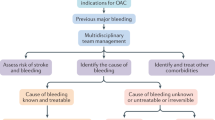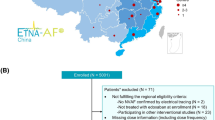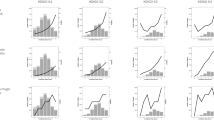Abstract
Atrial fibrillation is an important cause of preventable, disabling stroke and is particularly frequent in patients with chronic kidney disease (CKD). Stage 3 CKD is an independent risk factor for stroke in patients with atrial fibrillation. Warfarin anticoagulation is efficacious for stroke prevention in atrial fibrillation patients with stage 3 CKD, but recent observational studies have challenged its value for patients with end-stage renal disease and atrial fibrillation. Novel oral anticoagulants such as dabigatran, apixaban and rivaroxaban are at least as efficacious as warfarin with reduced risks of intracranial haemorrhage. However, all these agents undergo renal clearance to varying degrees, and hence dosing, efficacy, and safety require special consideration in patients with CKD. Overall, the novel oral anticoagulants have performed well in randomized trials of patients with stage 3 CKD, with similar efficacy and safety profiles as for patients without CKD, albeit requiring dosing modifications. The required period of discontinuation of novel oral anticoagulants before elective surgery is longer for patients with CKD owing to their reduced renal clearance. Although much remains to be learned about the optimal use of these new agents in patients with CKD, they are attractive anticoagulation options that are likely to replace warfarin in coming years.
Key Points
-
Atrial fibrillation is particularly frequent in patients with chronic kidney disease (CKD)
-
Stage 3 CKD is an independent risk factor for stroke in patients with atrial fibrillation
-
Recent observational studies have challenged the value of warfarin anticoagulation for patients with end-stage renal disease and atrial fibrillation
-
Novel oral anticoagulants such as dabigatran, apixaban and rivaroxaban are noninferior or superior to warfarin, with reduced risks of intracranial haemorrhage
-
In randomized trials to date, the novel oral anticoagulants have performed well in patients with stage 3 CKD, with similar efficacy and safety profiles as for patients without CKD, although dosing modifications are required
-
The required period of discontinuation of novel oral anticoagulants before elective surgery is longer for patients with CKD than for patients without renal dysfunction
This is a preview of subscription content, access via your institution
Access options
Subscribe to this journal
Receive 12 print issues and online access
$209.00 per year
only $17.42 per issue
Buy this article
- Purchase on Springer Link
- Instant access to full article PDF
Prices may be subject to local taxes which are calculated during checkout

Similar content being viewed by others
References
Go, A. S. et al. for the ATRIA Study Investigators. Impact of proteinuria and glomerular filtration rate on risk of thromboembolism in atrial fibrillation. The Anticoagulation and Risk Factors in Atrial Fibrillation (ATRIA) Study. Circulation 119, 1363–1369 (2009).
Soliman, E. Z. et al. Chronic kidney disease and prevalent atrial fibrillation: the Chronic Renal Insufficiency Cohort (CRIC). Am. Heart J. 159, 1102–1107 (2010).
Baber, U. et al. Association of chronic kidney disease with atrial fibrillation among adults in the United States: Reasons for Geographic and Racial Differences in Stroke (REGARDS) Study. Circ. Arrhythm. Electrophysiol. 4, 26–32 (2011).
Eikelboom, J. W. & Weitz, J. I. New anticoagulants. Circulation 121, 1523–1532 (2010).
Ansell, J. New oral anticoagulants should not be used as first-line agents to prevent thromboembolism in patients with atrial fibrillation. Circulation 125, 165–170 (2012).
Granger, C. B. & Armaganijan, L. V. Newer oral anticoagulants should be used as first-line agents to prevent thromboembolism in patients with atrial fibrillation and risk factors for stroke or thromboembolism. Circulation 125, 159–164 (2012).
The ACTIVE Investigators. Effect of clopidogrel added to aspirin in patients with atrial fibrillation. N. Engl. J. Med. 360, 2066–2078 (2009).
Connolly, S. et al. Clopidogrel plus aspirin versus oral anticoagulation for atrial fibrillation in the Atrial fibrillation Clopidogrel Trial with Irbesartan for prevention of Vascular Events (ACTIVE W): a randomised controlled trial. Lancet 367, 1903–1912 (2006).
Connolly, S. J. et al. Dabigatran versus warfarin in patients with atrial fibrillation. N. Engl. J. Med. 361, 1139–1151 (2009).
Connolly, S. J. et al. for the AVERROES Steering Committee and Investigators. Apixaban in patients with atrial fibrillation. N. Engl. J. Med. 364, 806–817 (2011).
Patel, M. R. et al. Rivaroxaban versus warfarin in nonvalvular atrial fibrillation. N. Engl. J. Med. 365, 883–891 (2011).
Granger, C. B. et al. for the ARISTOTLE Committees and Investigators. Apixaban versus warfarin in patients with atrial fibrillation. N. Engl. J. Med. 365, 981–992 (2011).
Executive Steering Committee on behalf of the SPORTIF III Investigators. Stroke prevention with the oral direct thrombin inhibitor ximelagatran compared with warfarin in patients with non-valvular atrial fibrillation (SPORTIF III): randomised controlled trial. Lancet 362, 1691–1698 (2003).
SPORTIF Executive Steering Committee for the SPORTIF V Investigators. Ximelagatran vs warfarin for stroke prevention in patients with nonvalvular atrial fibrillation: a randomized trial. JAMA 293, 690–698 (2005).
Ruff, C. T. et al. Evaluation of the novel factor Xa inhibitor edoxaban compared with warfarin in patients with atrial fibrillation: design and rationale for the Effective aNticoaGulation with factor xA next GEneration in Atrial Fibrillation-Thrombolysis In Myocardial Infarction study 48 (ENGAGE AF-TIMI 48). Am. Heart J. 160, 635–641 (2010).
Kaatz, S. et al. Guidance on the emergent reversal of oral thrombin and factor Xa inhibitors. Am. J. Hematol. 87 (Suppl. 1), S141–S145 (2012).
Hart, R. G. et al. Intracranial hemorrhage in atrial fibrillation patients during anticoagulation with warfarin or dabigatran: the RE-LY trial. Stroke 43, 1511–1517 (2012).
Harper, P., Young, L. & Merriman, E. Bleeding risk with dabigatran in the frail elderly. N. Engl. J. Med. 366, 864–866 (2012).
U. S. Food and Drug Administration. Pradaxa (dabigatran etexilate mesylate): drug safety communication—safety review of post-market reports of serious bleeding events[online], (2011).
Connolly, S. J. et al. on behalf of the ACTIVE W Investigators. Benefit of oral anticoagulant over antiplatelet therapy in atrial fibrillation depends on the quality of international normalized ratio control achieved by centers and countries as measured by time in therapeutic range. Circulation 118, 2029–2037 (2008).
White, H. D. et al. Comparison of outcomes among patients randomized to warfarin therapy according to anticoagulant control: results from SPORTIF III and V. Arch. Intern. Med. 167, 239–245 (2007).
Jones, M. et al. Evaluation of the pattern of treatment, level of anticoagulation control, and outcome of treatment with warfarin in patients with non-valvular atrial fibrillation: a record linkage study in a large British population. Heart 91, 472–477 (2005).
Baker, W. L., Cios, D. A., Sander, S. D. & Coleman, C. I. Meta-analysis to assess the quality of warfarin control in atrial fibrillation patients in the United States. J. Manag. Care Pharm. 15, 244–252 (2009).
Rose, A. J., Ozonoff, A., Henault, L. E. & Hylek, E. M. Warfarin for atrial fibrillation in community-based practise. J. Thromb. Haemost. 6, 1647–1654 (2008).
Fox, K. A. et al. Prevention of stroke and systemic embolism with rivaroxaban compared with warfarin in patients with non-valvular atrial fibrillation and moderate renal impairment. Eur. Heart J. 32, 2387–2394 (2011).
To, A. C., Yehia, M. & Collins, J. F. Atrial fibrillation in haemodialysis patients: do guidelines for anticoagulation apply? Nephrology (Carlton) 12, 441–447 (2007).
Limdi, N. A. et al. Kidney function influences warfarin responsiveness and hemorrhagic complications. J. Am. Soc. Nephrol. 20, 912–921 (2009).
Crowther, M. A. et al. Low-intensity warfarin is ineffective for the prevention of PTFE graft failure in patients on hemodialysis: a randomized controlled trial. J. Am. Soc. Nephrol. 13, 2331–2337 (2002).
Eikelboom, J. W. et al. Stroke risk and efficacy of apixaban in atrial fibrillation patients with moderate chronic kidney disease. J. Stroke Cerebrovasc. Dis. (in press).
Hart, R. G., Pearce, L. A., Asinger, R. W. & Herzog, C. A. Warfarin in atrial fibrillation patients with moderate chronic kidney disease. Clin. J. Am. Soc. Nephrol. 6, 2599–2604 (2011).
Nakagawa, K. et al. Chronic kidney disease and CHADS2 score independently predict cardiovascular events and mortality in patients with nonvalvular atrial fibrillation. Am. J. Cardiol. 107, 912–916 (2011).
Gage, B. F. et al. Validation of clinical classification schemes for predicting stroke: results from the National Registry of Atrial Fibrillation. JAMA 285, 2864–2870 (2001).
Stroke Risk in Atrial Fibrillation Working Group. Independent predictors of stroke in patients with atrial fibrillation: a systematic review. Neurology 69, 546–554 (2007).
Lip, G. Y., Frison, L., Halperin, J. L. & Lane, D. A. Comparative validation of a novel risk score for predicting bleeding risk in anticoagulated patients with atrial fibrillation: the HAS-BLED (Hypertension, Abnormal Renal/Liver Function, Stroke, Bleeding History or Predisposition, Labile INR, Elderly, Drugs/Alcohol Concomitantly) score. J. Am. Coll. Cardiol. 57, 173–180 (2011).
Shireman, T. I. et al. Development of a contemporary bleeding risk model for elderly warfarin recipients. Chest 130, 1390–1396 (2006).
Fang, M. C. et al. A new risk scheme to predict warfarin-associated hemorrhage: The ATRIA (Anticoagulation and Risk Factors in Atrial Fibrillation) Study. J. Am. Coll. Cardiol. 58, 395–401 (2011).
Gage, B. F. et al. Clinical classification schemes for predicting hemorrhage: results from the National Registry of Atrial Fibrillation (NRAF). Am. Heart J. 151, 713–719 (2006).
Loewen, P. & Dahri, K. Risk of bleeding with oral anticoagulants: an updated systematic review and performance analysis of clinical prediction rules. Ann. Hematol. 90, 1191–1200 (2011).
Cockcroft, D. W. & Gault, M. H. Prediction of creatinine clearance from serum creatinine. Nephron 16, 31–41 (1976).
U. S. Food and Drug Administration. Dabigatran Briefing Document[online], (2010).
Eikelboom, J. W. et al. Risk of bleeding with 2 doses of dabigatran compared with warfarin in older and younger patients with atrial fibrillation: an analysis of the Randomized Evaluation of Long-Term Anticoagulant Therapy (RE-LY) Trial. Circulation 123, 2363–2372 (2011).
U. S. Food and Drug Administration. FDA approved drug products: label information for PRADAXA[online], (2010).
U. S. Food and Drug Administration. FDA approved drug products: Xarelto[online], (2011).
Health Canada. Drugs and Health Products: Pradax[online], (2010).
Health Canada. Drugs and Health Products: Xarelto[online], (2012).
European Medicines Agency. Product information: Pradaxa[online], (2012).
European Medicines Agency. Product information: Xarelto[online], (2012).
Stangier, J., Rathgen, K., Stähle, H. & Mazur, D. Influence of renal impairment on the pharmacokinetics and pharmacodynamics of oral dabigatran etexilate: an open-label, parallel-group, single-centre study. Clin. Pharmacokinet. 49, 259–268 (2010).
Skanes, A. C. et al. Focused 2012 update of the Canadian Cardiovascular Society atrial fibrillation guidelines: recommendations for stroke prevention and rate/rhythm control. Can. J. Cardiol. 28, 125–136 (2012).
Warkentin, T. E. et al. Recombinant factor VIIa (rFVIIa) and hemodialysis to manage massive dabigatran-associated postcardiac surgery bleeding. Blood 119, 2172–2174 (2012).
van Ryn, J. et al. Dabigatran etexilate—a novel, reversible, oral direct thrombin inhibitor: interpretation of coagulation assays and reversal of anticoagulant activity. Thromb. Haemost. 103, 1116–1127 (2010).
Chan, K. E., Lazarus, J. M., Thadhani, R. & Hakim, R. M. Warfarin use associates with increased risk for stroke in hemodialysis patients with atrial fibrillation. J. Am. Soc. Nephrol. 20, 2223–2233 (2009).
Genovesi, S. et al. Prevalence of atrial fibrillation and associated factors in a population of long-term hemodialysis patients. Am. J. Kidney Dis. 46, 897–902 (2005).
Wetmore, J. B. et al. The prevalence of and factors associated with chronic atrial fibrillation in Medicare/Medicaid-eligible dialysis patients. Kidney Int. 81, 469–476 (2012).
Vázquez, E. et al. Comparison of prognostic value of atrial fibrillation versus sinus rhythm in patients on long-term hemodialysis. Am. J. Cardiol. 92, 868–871 (2003).
Wizemann, V. et al. Atrial fibrillation in hemodialysis patients: clinical features and associations with anticoagulant therapy. Kidney Int. 77, 1098–1106 (2010).
Genovesi, S. et al. Atrial fibrillation and morbidity and mortality in a cohort of long-term hemodialysis patients. Am. J. Kidney Dis. 51, 255–262 (2008).
Winkelmayer, W. C., Liu, J., Setoguchi, S. & Choudry, N. K. Effectiveness and safety of warfarin initiation in older hemodialysis patients with atrial fibrillation. Clin. J. Am. Soc. Nephrol. 6, 2662–2668 (2011).
Chou, C. Y. et al. Outcome of atrial fibrillation among patients with end-stage renal disease. Nephrol. Dial. Transplant. 25, 1225–1230 (2010).
McMahon, D. A., Smith, D. M., Carey, M. A. & Zhou, X. H. Risk of major hemorrhage for outpatients treated with warfarin. J. Gen. Intern. Med. 13, 311–316 (1998).
Elliott, M. J., Zimmerman, D. & Holden, R. M. Warfarin anticoagulation in hemodialysis patients: a systematic review of bleeding rates. Am. J. Kidney Dis. 50, 433–440 (2007).
Holden, R., Harman, G. J., Wang, M., Holland, D. & Day, A. G. Major bleeding in hemodialysis patients. Clin. J. Am. Soc. Nephrol. 3, 105–110 (2008).
Holden, R. M. & Booth, S. L. Vascular calcification in chronic kidney disease: the role of vitamin K. Nat. Clin. Pract. Nephrol. 3, 522–523 (2007).
Hart, R. G., Pearce, L. A. & Aguilar, M. I. Meta-analysis: antithrombotic therapy to prevent stroke in patients who have nonvalvular atrial fibrillation. Ann. Intern. Med. 146, 857–867 (2007).
K/DOQI Workgroup. K/DOQI clinical practice guidelines for cardiovascular disease in dialysis patients. Am. J. Kidney Dis. 45, S1–S153 (2005).
Chan, K. E., Lazarus, J. M., Thadhani, R. & Hakim, R. M. Anticoagulant and antiplatelet usage associates with mortality among hemodialysis patients. J. Am. Soc. Nephrol. 20, 872–881 (2009).
Yang, F., Chou, D., Schweitzer, P. & Hanon, S. Warfarin in haemodialysis patients with atrial fibrillation: what benefit? Europace 12, 1666–1672 (2010).
Marinigh, R., Lane, D. A. & Lip, G. Y. Severe renal impairment and stroke prevention in atrial fibrillation: implications for thromboprophylaxis and bleeding risk. J. Am. Coll. Cardiol. 57, 1339–1348 (2011).
Herzog, C. A. et al. Cardiovascular disease in chronic kidney disease. A clinical update from Kidney Disease: Improving Global Outcomes (KDIGO). Kidney Int. 80, 572–586 (2011).
Barany, P. Warfarin treatment in ESRD: Survey Results[online], (2012).
Levey, A. S. et al. for the CKD-EPI (Chronic Kidney Disease Epidemiology Collaboration). A new equation to estimate glomerular filtration rate. Ann. Intern. Med. 150, 604–612 (2009).
Levey, A. S. & Coresh, J. Chronic kidney disease. Lancet 379, 165–180 (2012).
Stevens, L. A., Coresh, J., Greene, T. & Levey, A. S. Assessing kidney function—measured and estimated glomerular filtration rate. N. Engl. J. Med. 354, 2473–2483 (2006).
Levey, A. S. et al. A more accurate method to estimate glomerular filtration rate from serum creatinine: a new prediction equation. Modification of Diet in Renal Disease Study Group. Ann. Intern. Med. 130, 461–470 (1999).
Coresh, J. et al. Calibration and random variation of the serum creatinine assay as critical elements of using equations to estimate glomerular filtration rate. Am. J. Kidney Dis. 39, 920–929 (2002).
Author information
Authors and Affiliations
Contributions
All authors contributed equally to discussion of content for the article, researching data to include in the manuscript, and reviewing and editing of the manuscript before submission. R. G. Hart and J. W. Eikelboom wrote the manuscript.
Corresponding author
Ethics declarations
Competing interests
R. G. Hart has worked as a consultant for Boehringer Ingelheim and received grant/research support from Bayer Pharmaceuticals and Bristol-Myers Squibb. J. W. Eikelboom has received grant/research support from Bayer Pharmaceuticals, Boehringer Ingelheim and Bristol-Myers Squibb. C. A. Herzog has received research support from and has equity interest (<$10,000) in Johnson and Johnson. A. J. Ingram declares no competing interests.
Rights and permissions
About this article
Cite this article
Hart, R., Eikelboom, J., Ingram, A. et al. Anticoagulants in atrial fibrillation patients with chronic kidney disease. Nat Rev Nephrol 8, 569–578 (2012). https://doi.org/10.1038/nrneph.2012.160
Published:
Issue Date:
DOI: https://doi.org/10.1038/nrneph.2012.160
This article is cited by
-
Cerebrovascular events, bleeding complications and device related thrombi in atrial fibrillation patients with chronic kidney disease and left atrial appendage closure with the WATCHMAN™ device
BMC Cardiovascular Disorders (2019)
-
Nicht-Vitamin-K-abhängige orale Antikoagulanzien (NOAK) bei chronischer Niereninsuffizienz
Der Nephrologe (2018)
-
Creatinine Versus Cystatin C: Differing Estimates of Renal Function in Hospitalized Veterans Receiving Anticoagulants
Journal of General Internal Medicine (2018)
-
Managing direct oral anticoagulants in patients undergoing dentoalveolar surgery
British Dental Journal (2017)
-
Chronic kidney disease and anticoagulation: from vitamin K antagonists and heparins to direct oral anticoagulant agents
Internal and Emergency Medicine (2017)





